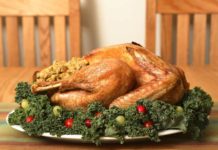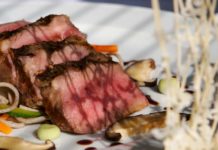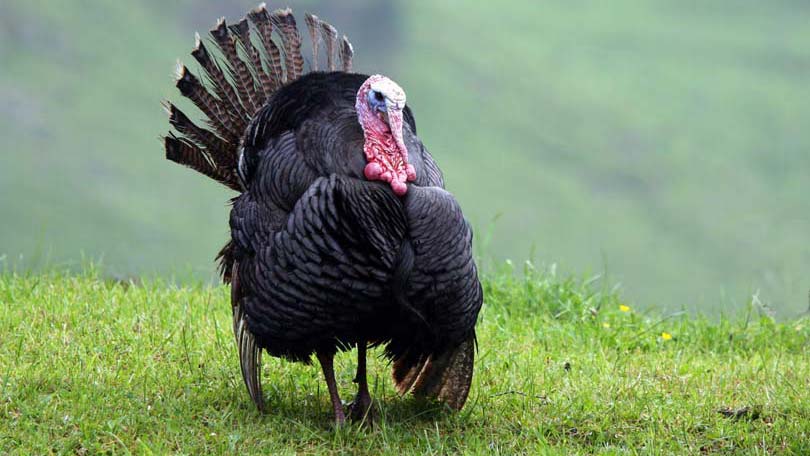
Perky Turkey, or Don’t Be a Nerd…Fry the Bird…
It has become somewhat trendy now to offer fried turkey during the holidays. And what’s not to like? The super crispy thin skin, or the moist, tender meat? When it’s done right, fried turkey is hard to beat.
But what about when things don’t go right? Reports come in every year about turkey frying disasters. Apparently, it is such a danger that the Department of Homeland Security has issued a warning this year on their Twitter feed about the dangers of frying turkeys. Who would’ve ever thought that a cooking method could become a matter of National Security? Is frying a turkey really that much more dangerous than other cooking methods? Let’s examine the issue…
According to the National Fire Prevention Association, each year, 5 people are killed, over 60 people injured, and over 900 homes are destroyed in incidents involving turkey fryers. Of course, all of these incidents are tragic, but in a country with a population of over 321 million, is that enough to constitute a threat to National Security? It seems a bit hysterical to me, but that’s just my opinion. By comparison, according to the National Highway Traffic Safety Administration, as of 2016, an average of 102 people die every day from car accidents, but no one seems to be afraid to continue driving. I haven’t heard anything from Homeland Security about that. And what about other home cooking methods? The same statistics for other cooking methods show that an average of 480 people die, over 4000 people will be injured, and over 700 million dollars of property will be damaged, all by cooking. These figures do not include restaurants, being cut by meat slicers and knives, slips and falls, or other common kitchen injuries. I really don’t understand why the focus seems to be all negative towards Turkey Fryers, but I seldom understand mainstream media anyway, so I’m not going to worry about it…
In reality, once all the hype and hysteria is weeded out, frying a turkey is no more dangerous than any other type of cooking, as long as the proper safety precautions and procedures are followed. There is no reason why you can’t enjoy a heaping helping of some delicious fried turkey this year. To this end, I am going to give you some tips to help you make your bird all that it can be.
Why Deep Fry a Turkey?
Frying turkey began as part of the Cajun Cooking craze in the 1970s. Large outdoor propane cookers were used in Louisiana to boil crawfish in massive quantities for huge get-togethers. Someone figured out that you could replace the water with oil, and fry whole turkeys with the same equipment, starting a national trend. It becomes more popular every year. But why?
Most people would agree that fried foods are incredible. A thin, potato chip-like crust with moist, tender and very flavorful meat is an almost irresistible treat. Turkeys are no exception. A properly fried turkey will have an incredible thin, crispy crust, and the meat will remain moist, with all of its flavor intact. The reason is because the hot oil immediately sears the outside of the bird, holding all of the juices and fats inside, so nothing is lost. The turkey cooks much faster (usually less than 1 hour), so there is less danger of the meat getting dry. Think of the difference between baked and fried chicken. Both are great, but most of the time, which do you prefer? Col. Sanders did not create his culinary empire with roasted chicken….
Of course, like anything else, there are also a few downsides to the issue. Many aficionados will try to tell you that frying a turkey is much quicker than roasting one, but this is only true if you don’t count the prep time, time to heat up the oil, clean-up time, and the task of storing and/or disposing of several gallons of used cooking oil. You are also limited as to the size of the bird you can safely fry. Many fryers claim that they can handle any bird up to 18 pounds, but I strongly recommend that you never try to fry any bird larger than 15 pounds, no matter what the manual says. Anything larger increases the risk of a spill-over exponentially. Besides, smaller turkeys fry better. Your better off frying 2 smaller turkeys rather than one large bird. Frying a turkey also requires the use of some specialized equipment, such as a fire-retardant apron, gloves, eye protection in the form of goggles, and a lot of oil. Is it worth it? Well,…several million people think so. And besides…, it’s fun and incredibly cool…
Know Your Equipment
One thing to keep in mind is that it is very important that you know your equipment, and understand how to use it properly and safely. Most mishaps involve people using their fryers for the first time. Be sure to read your Owner’s Manuals from cover to cover, or at least the parts that are written in your language. Make sure you understand how to properly assemble and use your unit. There are many great video tutorials on YouTube, absolutely free to watch. Take advantage of your learning resources. If you have a friend with experience in frying turkeys, it’s a really good idea to get them to supervise you on your first solo flight. Above all, think Safety First. If in doubt, always err on the side of caution. This is true for all types of cooking…
With that being said, let’s take a look at what kinds of equipment you may be using. Turkey fryers are pretty basic. There are two kinds; an outdoor fryer, which is the most popular, and an indoor type, which is basically a large deep fryer with a rotisserie attachment. Outdoor fryers are almost always propane-powered, while indoor fryers are invariably electric.
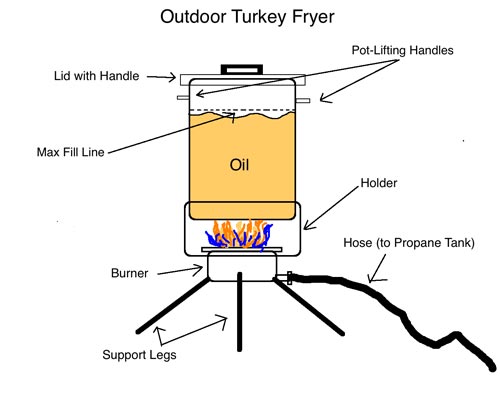
As you can see, an outdoor fryer consists of an aluminum pot to heat the oil in, and hold the turkey. They usually need around 5 gallons of oil. It has a lid, mostly for safety reasons, and two handles to facilitate moving the pot when necessary. The pot sits in a holder mounted above a propane burner, which is attached to a hose that runs to a standard propane tank, which is usually not included in the purchase, but can be found in almost any hardware store, as well as other places. There is sometimes a valve near the hose fitting that lets you adjust the propane gas flow, thus regulating the temperature. Or, you may just have to use the valve on the propane tank itself. Either way works fine. The entire unit is supported by 3 or 4 legs that hold everything up off of the ground to lessen the chance of starting a fire. Accessories will include a coat hanger-shaped wire rack, used to raise and lower the turkey into and out of the hot oil, and sometimes an oil thermometer. If not, you will definitely need to buy an oil thermometer, and it’s also a good idea to have a meat thermometer as well. We’ll get into those in the next section. As we said earlier, other things you will need are a fire retardant apron, gloves, goggles for eye protection, and a fire extinguisher rated for Class B fires (a large box of baking soda works well as a Type B extinguisher as well).
The advantages of outdoor fryers are that they cost a lot less than indoor fryers, are simple to use and maintain, and are safer, because any mishaps will be outside, and not in the house.
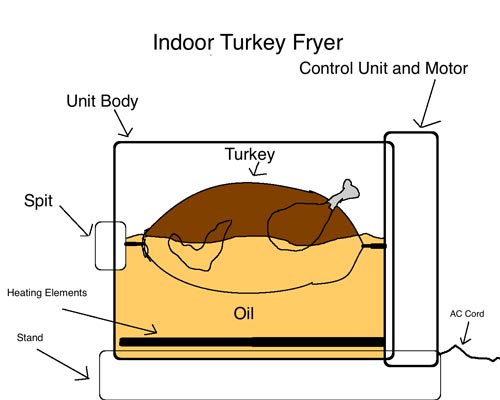
Indoor Turkey Fryers are pretty easy to use. All you have to do to heat them up is plug them in and set your temperature. They require less oil, because the turkey is only half-submerged, and they rotate while cooking so all sides get cooked evenly. Indoor fryers can use as little as 2-1/2 gallons of oil, maybe even less. They can also be used just like any other deep fryer to fry large amounts of french fries, chicken, fish, etc… They usually have a temperature control, and some even have timers. The spit spins the turkey slowly through the oil. The advantages of indoor fryers are ease of use, using less oil, and are less likely to start a fire in the event of a mishap. If you live up north, it may not be desirable to try to fry a turkey outside during a blizzard, snowstorm, rain, or very cold temperatures. An indoor fryer solves that problem.
Prepping For Frying
Before we get into the prep and frying part, the first thing to do is observe safety precautions. Before setting up your fryer, here are the things you should always do:
- The area should be under control at all times. Put your pets in the pen, or wherever, so that they cannot get into the area where you will be frying. Let the children play at a neighbors house, break out the video games, or whatever you need to do to make sure they stay away from the frying area.
- Always use protective gear when using the fryer.
- Never, never, never leave the fryer unattended when it is in operation, not even for a second. If you need to go to the restroom, or whatever, have someone spell you.
- Never use an outdoor fryer indoors, and vice versa. Never use an outdoor fryer in an enclosed space of any kind.
- Make sure the immediate area is free of anything that might be flammable, such as debris, paper, boxes, vegetation, paints and solvents, etc…. The area should be clear for at least 25 feet in all directions. This includes the house, and or garage, storage sheds, etc…
- Always have a fire extinguisher within reach while using the fryer.
- Make sure your turkey is completely thawed out and dry before lowering it into the oil. This is the #1 cause of turkey fryer mishaps. Any water will cause the oil to boil over into the burner, creating a spectacular flame up and fire show.
- Never fill your fryer with oil past the maximum oil marker. It is best to stay below the line.
- Alcohol and or drugs do not mix well with things that make flames or can explode. Leave the cocktails, beer, and wine for later, after you’ve earned it. If your prescription medications advise you not to drive while taking them, then don’t fry either. Let someone else do it, while you supervise… Make sure you are well rested, and don’t try to fry a turkey when you are sleepy. Be physically prepared, and alert.
Prepping for frying a turkey starts well before the actual frying, as much as 10 days in advance. The first thing to do is select a turkey. As we said earlier, smaller is better. A 15 pound bird is ideal. Whether you use a Hen or a Tom turkey is a matter of personal preference. Hens are smaller and have smaller bones, so they may be slightly preferable to Toms for frying.
A B-B-B-Bird, Bird, Bird. The Bird Is The Word…
All turkeys are not created equal. There is actually a very wide spread of quality available, ranging from what I consider to be marginally edible, to outstanding, and price is not always the indicating factor.
Whether you use a fresh or frozen turkey is up to personal preference and availability. Unfrozen turkeys are seldom available in time to properly prepare them for frying. They are usually only available right before the holidays, within a day or two. Heritage Turkeys must be ordered a year or more in advance, and are only killed and dressed when ready to be prepped and cooked. However, they have the best texture and flavor of any turkey you can buy, by a large margin. The best Heritage breeds are Narragansetts and Bourbon Reds. Wild Turkeys have to be harvested during the legal hunting seasons, but are superior to any other turkey in terms of taste, texture, and are perfectly sized for frying. The drawback is that they have less white meat than all other turkeys, but the dark meat is so good…who cares???
The next thing to consider is the way the turkey was processed. You have a few choices:
- Self-Basting, or Injected Turkeys: These birds have had vegetable oil and saline solutions injected into them during processing, supposedly to keep them moist during cooking, but actually, it is done to add preservatives, color enhancers and extra flavors to offset the blandness of the commercially raised turkey breeds. The meat texture is somewhat stringy. Since they are already injected, brining may give you a different and unexpected result. The only advantages to these are that they are cheap, and widely available.
- Natural Turkeys: By USDA Regulations, turkeys labeled as “Natural” have to be raised without the use of animal by-product feeds, must be free range, and never been given growth hormones, or antibiotics, except for external parasite control. They cannot be processed with any additives, preservatives, or extra flavorings whatsoever. These are only nominally more expensive than Self-Basting birds, and are much better in terms of flavor and texture.
- Organic Turkeys: By USDA Regulations, they must meet all the criteria for a “Natural” certification, and also be Free-Range. Free Range is sort of misleading as far as commercial turkeys go, for reasons I’ll explain shortly. Suffice to say you can ignore the “Free-Range” labeling on any commercial turkey.
- Heritage Turkeys: Top-of-the-Line for a purchased turkey, by any standard you want to set. These are very specific breeds, raised humanely, and actually are free roaming for their entire lives, have never been fed artificial, GMO, or processed feeds, antibiotics, hormones, and have no preservatives or artificial ingredients added during processing. They must be ordered at least a year in advance, as a rule, and are custom-raised to your specifications. They are only harvested at the last minute, when you are actually ready to prep them. The flavor and texture is superior to any other bird, save for a wild turkey you harvested yourself. They are leaner, and have less white meat than a commercial turkey, but the dark meat is superior in flavor to a commercial turkey’s white meat. They can cost upwards from around $6.00 per pound, but are more than worth it. Everyone should try a Heritage bird at least once in their lives…
*Note-A word about commercially bred turkeys: Any supermarket turkey you buy will be of one breed, and one breed only; the Broadbreasted White. They are so far removed from a real wild turkey that I don’t think they should be allowed to be called turkeys. They cannot breed with a wild turkey. These birds have been selectively bred to produce a turkey with the maximum amount of white meat possible. Their breasts are so large that they can’t even mate by themselves, and have to be artificially enseminated. As for “Free-Range”, Broadbraested Whites are so top-heavy that they can barely walk, so just because they left the pen door open, that doesn’t mean the turkey went out for a long stroll. Whites don’t ‘Range’ anywhere, and can barely waddle to the food dish. Without additives and flavorings, their meat is stringy and tasteless. If how the bird was raised and cared for is important to you, then your options are limited to Heritage or wild turkeys. I highly recommend Narragansetts and Bourbon Reds..outstanding birds.
Turkey Frying 101
We have our turkey. Now it’s time to go to work. If the turkey is frozen (most likely), we must thaw it out. Turkeys should be thawed in the refrigerator for at least 24 hours for every 4 pounds, so for a 15-lb. turkey, we are looking at 4 days to thaw. I will stress again, the turkey must be completely thawed before you attempt to fry it. Even ‘thawed’ or ‘previously-frozen” turkeys from the store are often still be frozen in the center, so they should also be thawed for at least a day, just to be sure.
This is going to sound really dumb, but the next thing to do is to remove the bag inside the body cavity that contains the liver, giblets, and the neck. It seems like common sense, but you would be surprised at how many people forget this and try to cook the turkey with the gut bag inside. It won’t ruin your turkey, but you will be the subject of many turkey jokes for years to come…. You can discard the parts, or re-freeze them to cook later in other things. The necks, in particular, make great turkey and rice or noodle soup, and the livers are wonderful fried by themselves, or wrapped in bacon and broiled. The giblets make outstanding gravy.
The next thing to do is to remove those dumb little plastic pop-outs, if your turkey has one. They are supposed to tell you when the turkey is done. They lie, and no decent cook needs a piece of plastic to tell them when a turkey is done. The plastic could melt during frying, or give off harmful chemicals when exposed to hot oil. Besides, they are just plain dumb and insulting.
Now we can get down to the important business of brining our bird. Nothing effects the outcome of your turkey as much as brining. It does more than just flavor the bird. It ensures that the moisture and flavorings become incorporated into each individual cell of the meat. You should always brine any meat you plan to roast, smoke or grill. The best way to do this is to get a food service bucket or large cooler, big enough to hold the turkey, and completely cover it with liquid and ice. Now, place the turkey in the container, and cover it with water. Next, remove the turkey and measure the water. This is how much brining liquid you will need. Be sure to adjust the water in the brine recipe to compensate for adding ice periodically. Make your brine according to your favorite recipe, and add it, and the turkey to your container. Top it off with as much ice as it will hold. Seal it with the lid. I allow 30 minutes per pound and it has always come out right, so for a 15 lb. turkey, allow at least 8 hours to brine. 12 hours is not too much, so overnight is fine. Check the ice every few hours and add more when necessary. Your turkey needs to stay in the 43º to 46º range while brining.
Once the brining is complete, remove the turkey from the brine, and discard the liquid. Do not ever use brine for anything after it has had raw meat in it. Next, rinse the bird very thoroughly inside and out, making sure to wash off all of the brine residue. Now, pat the bird completely dry inside and out. The drier the better. Place the bird in the refrigerator while you fire up the fryer. Be sure to use all the protective equipment and safety procedures. And most of all, make sure the turkey is secure when raising and lowering it, so as not to drop it into the oil.
If using an outdoor fryer, after you have gone through the safety checklist I previously mentioned, before you use any oil or apply any heat to the fryer, place the turkey in the fryer. Now, add enough oil to cover the bird, without going over the max fill line. If using an indoor fryer, follow the owners manual instructions for how much oil to add. Now, remove the bird, hold it over the pot and let as much oil drip off of if as possible. Some people use water to determine how much oil to use, but in my experience, you can never dry the pot back out enough by wiping it with a paper towel or cloth to be 100% sure it will not spit and splatter when the oil gets hot. My way is messier, but safer… Place the bird on a plate or tray and return it to the refrigerator or cooler until the oil is hot. You can wipe off the excess oil, or just leave it alone. It won’t hurt anything, but it may get your cooler messy.
*Note-A word about oils. For deep frying, I strongly suggest that you use nothing but either Cottonseed Oil or Peanut Oil. Cottonseed oil is the very best because it has no flavor or odor, an extremely high smoke point, and lasts longer than any other oil before breaking down or becoming rancid. Peanut oil has a very mild flavor and odor, a high smoke point, and last a good while before becoming unusable. All other oils have too low a smoke point, flame up easily, and break down in no time. Save the olive oil, coconut oil, vegetable oil, corn oil, etc… for pan frying and baking.
Now, according to your owners manual instructions, hook up your propane, light the burner and heat the oil to 350ºF, not 345ᵒ, not 365ᵒ, but 350ᵒ. Use a thermometer. When the oil gets hot, lower the turkey slowly into the oil, a little at a time. If the oil acts like it wants to boil up, raise the turkey a little until it calms back down. Once you have eased the turkey all the way in, unhook the handle. Allow the turkey to fry for about 3 minutes per pound, so a 15 lb. turkey will take around 45 minutes to fry. The turkey is done when the internal temperature reaches a minimum of 145ºF, but it’s not that critical. I have gone as high as 180ºF and the turkey was still fine. Turn off the burner and raise the turkey from the oil. Hold it over the pot for a few minutes and let the excess oil drain off. Your turkey is now perfect, and ready for presentation.
If using an indoor fryer, start by making sure the turkey is completely dry inside and out. Next, skewer the turkey on the spit. The bird must be secure on the spit, so the best way is to go through the breast just under the wishbone, and exit near one of the thighs. Now, you need to truss up all the loose parts like the wings and legs, so that they stay against the body, and not flop around while the bird is spinning. There are lots of ways to do this, so use your favorite method. I use kitchen string, and just tie everything against the body. Place the skewered and trussed turkey in the basket according to the manuals instructions. Give it a couple of spins to be sure nothing gets caught. If so, remove the turkey, fix it and try again. Once the turkey spins free, you are ready to fry. Fill the oil tank to the fill line or just below, and turn the unit on. When the oil reaches the correct cooking temperature, slowly lower the basket into the tank. From here, simply follow the manuals instructions. As a rule, allow 3 minutes per pound cooking time, so a 15 lb. bird will take about 45 minutes to cook. The bird is done when the internal temperature reaches a minimum of 145ºF. When the bird is done, turn off the rotisserie, raise the basket and place it in the drain holders so the oil can drain off the turkey. Turn off the unit.
Whichever fryer you use, your turkey is ready. Serve it however you want and enjoy. Once everything is cooled down, be sure to clean up and properly store everything. The oil can be stored and reused for up to 6 months. If you are disposing of it, please do it properly, and not just pour it out in the yard. It is very bad for the environment, Either place it into containers and take it to a recycling center, or put it in the trash. Never mix it with scented or disinfectant type kitty litters to solidify it. They can react with the oil and cause a spontaneous fire.
Conclusion
As long as proper procedures and safety precautions are followed, there is no reason why you can’t enjoy some delicious fried turkey this year. The extra work is more than worth it, and it is a lot of fun. Holidays only come around once a year, so make the most of it. Be a Frequent Fryer, and treat yourself, friends, family, neighbors, and whoever…to a memorable holiday feast this year.
Bon Apetit, and Happy Holidays…




